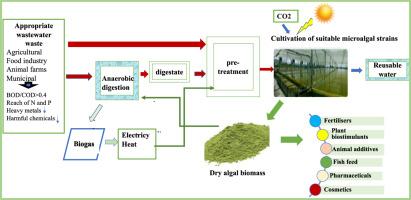Successful practices for valorization of microalgal biomass for inclusion in circular economy
IF 4.6
Q2 MATERIALS SCIENCE, BIOMATERIALS
引用次数: 0
Abstract
Global wastewater generation is enormous and continuously increasing, becoming a huge challenge to humanity. The use of wastewater for cultivation of microalgae has emerged as a potential cost-effective strategy for large-scale production of microalgae biomass. This strategy also offers an effective approach for removing nutrients from wastewater, making its treatment sustainable, eco-friendly and energy efficient. Among the different types of wastewater, wastewater from anaerobic digestion plants deserves attention, since this process generates a large amount of residue called digestate, reaching up to 90 % of the amount of substrate. Using the anaerobic digestate to cultivate algae is a way to reduce its harmful impact on the environment, improve the economic profitability of anaerobic digestion facilities and convert digestate from a waste to a beneficial by-product. By selecting and reviewing 129 articles published in Scopus between 2010 and 2024, the present review investigates and evaluates the possibilities of increasing the biomass value of microalgae cultivated in wastewater as a growth medium and highlights the importance of pre-selection of appropriate (non-toxic) wastewater to obtain usable “safe” microalgal biomass that can be further utilized to produce high added value products. The results indicated that the biomass of microalgae grown in non-toxic wastewater, including digestate, can have a number of economically and environmentally sustainable applications, the most important of which are its use as a feed, feed ingredient, ingredient of fish feed, as well as for the production of health-related compounds (proteins containing essential amino acids, polyunsaturated fatty acids, carotenoids, phycobiliproteins, polysaccharides, etc.), biofertilizers and biostimulants for agriculture. Cultivation of microalgae for the simultaneous treatment of non-toxic wastewater and obtaining biomass and high-value products can be an effective and prospective approach for the valorization of microalgae biomass within the modern concept of а circular bioeconomy.

将微藻生物质增值纳入循环经济的成功实践
全球废水产生量巨大且持续增长,已成为人类面临的巨大挑战。利用废水培养微藻已成为大规模生产微藻生物质的一种具有成本效益的潜在战略。这一策略也是去除废水中营养物质的有效方法,使废水处理具有可持续性、生态友好性和能源效率。在不同类型的废水中,厌氧消化工厂产生的废水值得关注,因为这一过程会产生大量残渣,即沼渣,最高可达基质量的 90%。利用厌氧消化物培养藻类是减少其对环境有害影响、提高厌氧消化设施经济效益以及将消化物从废物转化为有益副产品的一种方法。本综述选择并回顾了 2010 年至 2024 年期间在 Scopus 上发表的 129 篇文章,调查并评估了以废水为生长介质培养微藻以提高其生物量价值的可能性,并强调了预先选择适当(无毒)废水以获得可用的 "安全 "微藻生物量的重要性,这种生物量可进一步用于生产高附加值产品。研究结果表明,在无毒废水(包括沼渣)中培植的微藻生物质可用于多种经济和环境可持续发展的用途,其中最重要的是用作饲料、饲料配料、鱼饲料成分,以及生产与健康有关的化合物(含必需氨基酸的蛋白质、多不饱和脂肪酸、类胡萝卜素、藻蓝蛋白、多糖等)、生物肥料和农业生物刺激剂。在现代 "循环生物经济 "概念下,培养微藻同时处理无毒废水并获得生物量和高价值产品,是实现微藻生物量价值化的有效而有前景的方法。
本文章由计算机程序翻译,如有差异,请以英文原文为准。
求助全文
约1分钟内获得全文
求助全文

 求助内容:
求助内容: 应助结果提醒方式:
应助结果提醒方式:


